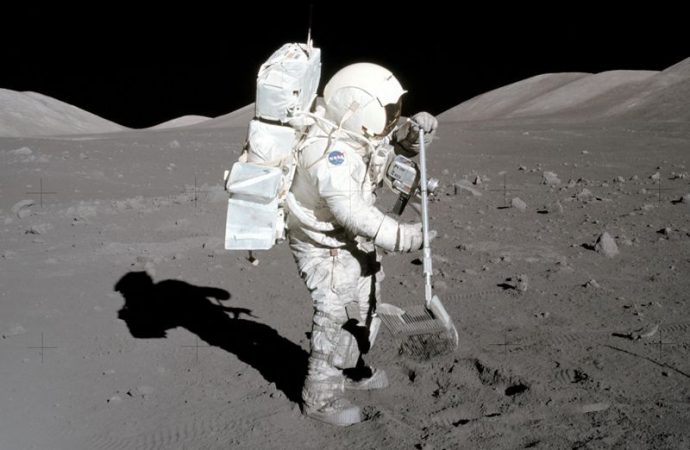Researchers can now analyze precious samples of lunar rock atom by atom
Source: Smithsonian Magazine
Nearly 50 years have passed since a human last set foot on the moon. But when team members of NASA’s 1972 Apollo 17 mission packed up for their return trip to Earth, they brought 245 pounds of the lunar ground they walked on back with them—for science, of course.
For decades, NASA has doled out the moon rock and regolith—now a precious resource—only sparingly as fodder for research. Now, scientists have found a new way to get the most of the precious, extraterrestrial material: A technique that analyzes moon rocks atom by atom. With this method, a single grain of lunar dust can give researchers here on Earth an extremely efficient glimpse into some of the unusual chemical reactions that happen atop our planet’s solo satellite, according to a study published last week in the journal Meteoritics & Planetary Science.
The findings constitute “the first time a lunar sample has been studied like this,” study author Jennika Greer, a geophysicist at the University of Chicago and Chicago’s Field Museum, says in a statement. “We’re using a technique many geologists haven’t even heard of.”
Though new to lunar science, the team used a method called atom probe tomography, which has been around for decades. The technique works by zapping samples with a laser, stripping atoms away one by one and funneling them toward a detector for analysis. Hailed for its ability to deduce a material’s composition with extraordinary resolution, the data spit out the other end can give researchers enough information to digitally reconstruct particles on an atomic scale.
After being granted access to Apollo 17’s lunar samples, Greer and her colleagues sent a grain of moon dust into an atom probe at Northwestern University. To avoid destroying the sample, they first carved a small, sharp tip into its surface, knocking atoms off only this spike and leaving the remainder intact. By observing how the sample’s individual atoms moved within the detector, the team was able to determine some of the elements dotting the moon’s mysterious surface at a microscopic level.
Though the dust was no wider than a human hair, it was found to contain bits of iron, water and helium. As Elizabeth Howell reports for Space.com, the latter two of these compounds are precious resources that could someday help sustain the activities of lunar landing missions. Greer and her colleagues also discovered evidence that their sample had undergone weathering in the harsh environment of space.
Unlike Earth, which is swaddled in a thick, protective atmosphere that helps shield our planet’s surface, the moon is surrounded by only a scant coating of gas, leaving lunar soil exposed to the cosmic elements. Battered by everything from cosmic rays to meteorites, the surface of the moon is constantly changing, leaving its exterior fundamentally different from the rock below. These differences could yield insights into how the moon has chemically evolved over time, and even help researchers make predictions about other planetary bodies too in the cosmos that are too far away to sample.
“It’s important to understand these materials in the lab so we understand what we’re seeing when we look through a telescope,” Greer says in the statement. “Because of something like this, we understand what the environment is like on the moon… This little grain preserves millions of years of history.”
The team’s study also opens the door to similar experiments with other extraterrestrial samples. Japan’s Hayabusa2 is expected to return to Earth later this year toting bits of the asteroid Ryugu; and NASA’s OSIRIS-REx mission will do the same for the asteroid Bennu in 2023.
“We can apply this technique to samples no one has studied,” study author Philipp Heck of the University of Chicago and the Field Museum says in the statement. “This technique has such high sensitivity and resolution, you find things you wouldn’t find otherwise and only use up a small bit of the sample… You’re almost guaranteed to find something new or unexpected.”
Source: Smithsonian Magazine

































Leave a Comment
You must be logged in to post a comment.